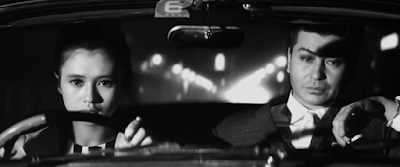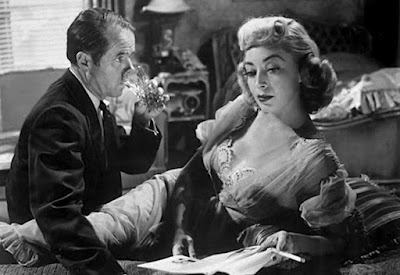 |
| A taste for danger. Saeko (Mariko Kaga), "Pale Flower" (1964). |
By Paul Parcellin
“Pale Flower” (1964)
It’s clear from the start that Masahiro Shinoda’s “Pale Flower” isn’t your typical yakuza picture — the kind that’s simmered in the Japanese underworld’s intricate codes of conduct, with a lead character who agonizes over prickly themes such as honor and loyalty.
“Pale Flower” covers the same slice of society as other yakuza films, but the soundtrack tips us off that we’re in for something different. Avant-garde classical composer Toru Takemitsu’s jagged, dissonant orchestral score is unlike anything we’d expect to hear in a crime film, regardless of its country of origin. It grabs our attention immediately and won’t let go.
A vision of Japan's underworld
Like Western films of its ilk, “Pale Flower” has a shadowy noir look, nervous edits and dreamy, hallucinatory imagery. It’s a vision of the Japanese underworld as Jean-Pierre Melville or Robert Bresson might have pictured it.
 |
| Saeko (Kaga) and Muraki (Ryô Ikebe) on the streets of Yokohama. |
Much like his European counterparts, director Shinoda, a founding member of the Japanese New Wave of filmmakers, infused “Pale Flower” with a sense of alienation and dislocation, reflecting the aftermath of brutal warfare in bygone times.
This is a gangster movie and a love story mashed into one, and if that sounds pretty conventional, it is — at least on the surface. But it’s also the story of Japan after World War II, defeated and held under the sway of the United States and the Soviet Union in the Cold War era.
Audio mosaics of layered, electronically enhanced sound that help define the overall feel of “Pale Flower.”
There’s a sense of ennui among the citizenry of Yokohama, where the story is set. Clocks keep ticking but time stands still, and denizens of this metropolis seem to exist in a state of suspended animation. Gangster business carries on, but emotional relationships seem stunted. The populace is numb, still recovering from a stunning wartime defeat. Traditional rituals and customs are practiced, but have a hollow ring.
Defining a mood with sound
The soundtrack reflects that dreamy yet unsettling mood, blending practical audio effects with orchestrated music. Takemitsu didn’t simply compose the score after the film was finished, he took part in the film’s development process, crafting audio mosaics of layered, electronically enhanced sound that help define the overall feel of “Pale Flower.”
 |
| Saeko and Muraki in a game of chance. |
In gambling den scenes, a central focus of the film, players shuffle what are supposed to be stiff, almost wooden, cardboard playing cards, known as hanafuda (in this case tile playing cards were used to accentuate the sound). Adding juice to the audio track, an electronically enhanced sound recording of two tap dancers seamlessly merges with the cacophony of clicking tiles. The result is a hypnotic percussion sequence that adds a surreal touch to scenes of drop-dead serious gamblers attending to business.
Another visually and sonically arresting scene takes place in a shop full of clocks. Their kinetic ticking, like the clicking and clacking of gambling cards, reminds us that clocks move forward, even if life here seems to stand still.Apart from its rich and varied tapestry of sound, “Pale Flower”’s on-screen action is mostly restrained and many scenes are dialogue heavy. But just as the drama begins to trail off an impromptu car race, nestled between more muted sequences, provides an adrenaline rush. The gasoline fueled competition is more than just squealing tires and revving engines. Like almost every facet of Shinoda’s film, the racing sequence offers rich details about the characters.
 |
| Muraki, out of prison and back to gang life. |
Saeko (Mariko Kaga), the mysterious love interest of fresh-out-prison Muraki (Ryō Ikebe), has a childlike, giggling manor. But her naive appearance masks her true self. She’s a thrill seeker addicted to danger and risk taking. Muraki, older and hardened to the ways the underworld, is deliberate in his actions and careful in each step he takes. But they bond over a shared sense of despair and boredom. Both lead lives of material comfort that lack intrinsic value.
Saeko, however, is more of a puzzle ... we see nothing of her life outside of her and Muraki’s nocturnal wanderings.
The source of Muraki’s depression stems from the crime that put him in prison — killing a member of a rival crime family. He learns that while he was in prison the dead man’s crime family merged with his gang, so the killing and the time he served had no strategic purpose or importance.
Saeko, however, is more of a puzzle. She seems to come from a family of means, but other than an unexpected, nerve racking encounter between her and Muraki in a public place (others are around so they pretend to be strangers), we see nothing of her life outside of her and Muraki’s nocturnal wanderings.
Their go-to respite, gambling, is the one activity that they enthusiastically share, but it’s not without its difficulties. It’s OK for a woman’s to be in a gaming room as long as she’s there to attend to a male gambler. But a female gambler is almost too much for the yakuza to stomach. The card tables are crowded with tattooed mobsters stripped to the waist, a virtual mountain of sweaty flesh which all but surrounds the delicate blossom as she takes her place with the boys. And she never bats an eyelash.
Stepping up her game
With Muraki speaking for her, Saeko is allowed to step up to increasingly higher-stakes betting. Muraki and her romance is mostly under wraps, almost non-existent you might say. Their shared malaise and gambling den outings are more important than love and sex. Saeko’s fixation with taking increasingly greater risks is sated by Muraki’s mob status, which opens gambling den doors. But he does so with growing misgivings. In her he sees a moth tempted by an open flame.
Based on an original story by Shintaro Ishihara, the film was scripted by Ataru Baba. Shinoda reworked the script significantly and Baba was not pleased with the result. He decried the film’s dynamic editing and soundtrack, which he felt obscures his interpretation of the story. Also troubling to the screenwriter was the film’s emphasis on nihilism, which was merely implicit in the script he labored over.
But nihilism is indeed the guiding force in “Pale Flower.” Consequently, bored, disenchanted risk-takers will in time face the peril their activities invite.
A troubling omen appears in the betting parlors when Yoh (Takashi Fujiki), a heroin addict who fled Hong Kong after committing two murders, lingers on the periphery of the gaming tables. He’s like an ever present angel of death who’s come to perch in their roost, casting a shadow that will forever fall over them.
In the meantime, Muraki’s present milieu is something like that of post-war Japan itself: both are shadows of their previous selves, and laboring to adapt to an inhospitable world. Like Japan, Muraki is unsure of his path forward, but is painfully aware that all things can change in an instant.







































